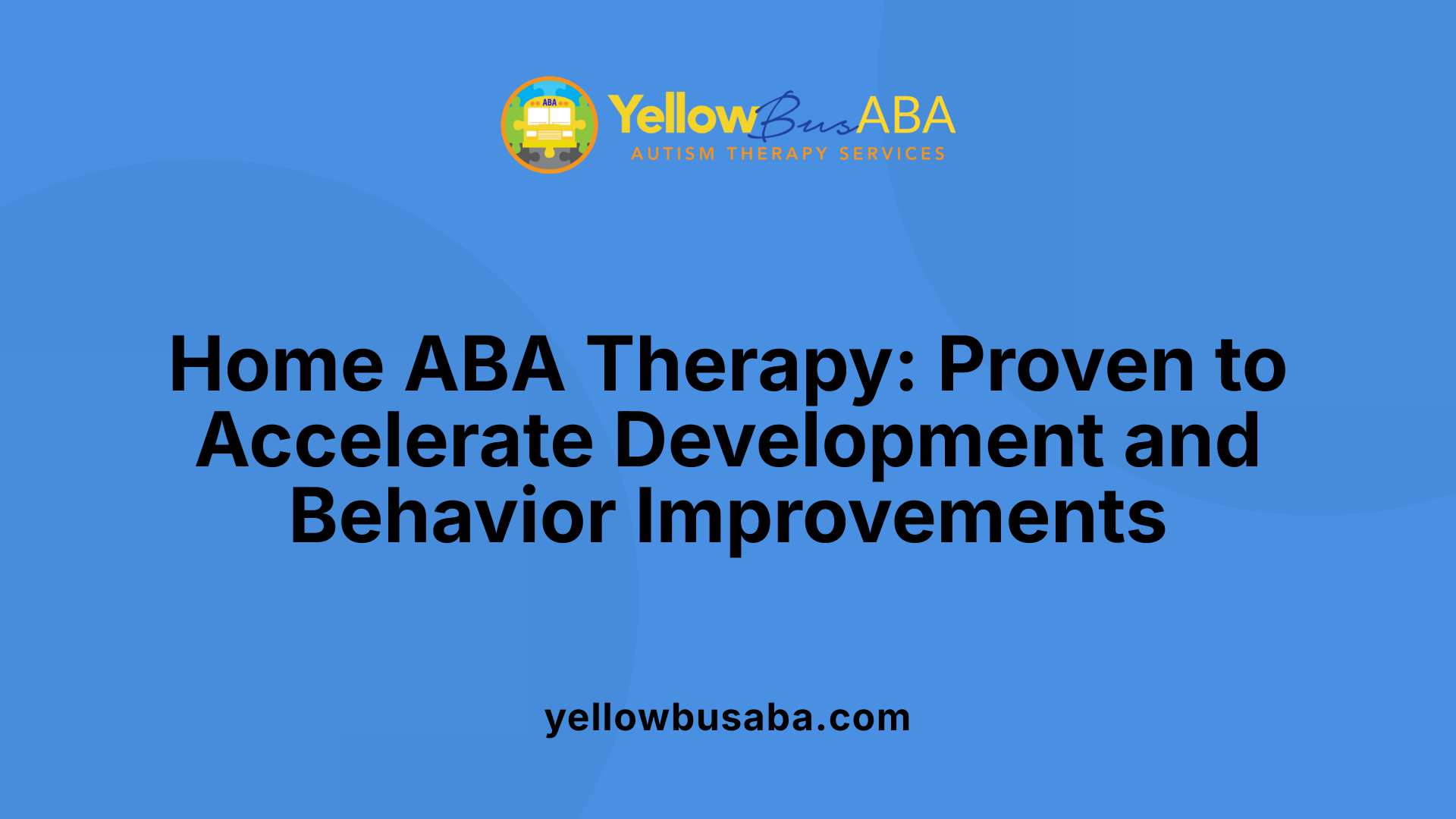Understanding Home-Based ABA Therapy for Young Children
Applied Behavior Analysis (ABA) therapy is widely recognized as a highly effective, evidence-based approach to supporting children diagnosed with autism spectrum disorder (ASD). When delivered in the comfort of a child's home, ABA therapy can profoundly impact development, offering tailored, natural, and family-centered interventions. This article explores the multifaceted benefits of home-based ABA therapy, emphasizing its effectiveness, personalization, and role in fostering independence and social skills.
Core Goals and Personalization of Home ABA Therapy

What are the goals of ABA therapy?
Applied Behavior Analysis (ABA) therapy aims to support children with autism spectrum disorder by fostering their growth in various essential areas. The primary goal is to develop individual strengths and critical life skills such as language, communication, attention, social skills, and independence. These skills are foundational for enabling children to participate actively in daily life and to improve their overall quality of life.
Through structured interventions, ABA therapy encourages positive behaviors and reduces problematic behaviors, helping children become more self-sufficient and socially engaged. The therapy focuses on practical skills that can be applied immediately, making a meaningful difference in the child’s everyday experiences.
How are treatment plans tailored to each child?
Every child with ASD is unique, which is why personalized treatment planning is central to effective ABA therapy. Board Certified Behavior Analysts (BCBAs) evaluate each child's current abilities, challenges, and environmental factors to create individualized plans.
These plans focus on targeted areas such as communication, social skills, and daily living routines. Continuous data collection and progress monitoring allow therapists to adjust strategies in real-time, ensuring the interventions remain relevant and effective.
Involving families in this process is crucial. Parents and caregivers are often trained to implement strategies at home, promoting skill generalization and consistency across different settings. This tailored approach maximizes the child's potential for growth and helps them achieve their full capabilities.
| Aspect | Focus | Details |
|---|---|---|
| Goals | Development of skills | Language, communication, attention, social skills, independence |
| Personalization | Ongoing assessment | Conducted by BCBAs to tailor interventions |
| Techniques | Data-driven adjustments | Continuous monitoring and family involvement |
| Settings | Natural environments | Home, community, or school environments |
Home-based ABA therapy’s personalized nature, combined with its focus on real-life skills, makes it a powerful tool for supporting children with ASD in reaching developmental milestones and fostering lifelong independence.
Advantages of the Home Environment for Learning

Why is the home environment beneficial for ABA therapy?
Delivering ABA therapy in the home setting makes children feel more comfortable and secure. This familiar environment allows children to relax and focus more easily on learning new skills. It also offers the chance for family members to participate actively in therapy, creating a stronger support system.
Because therapy takes place in the child's natural environment, practitioners can observe behaviors directly and adjust strategies more effectively. This personalized approach helps address the child's specific needs while fostering consistency across different routines and settings.
How does the natural setting improve skill acquisition?
Having therapy at home means children don't have to adapt to unfamiliar environments, which can sometimes be intimidating or overwhelming. This comfort can lead to quicker and more effective learning.
When children practice skills in settings where they naturally occur—like asking for a snack during lunchtime or taking turns during a game—they are more likely to generalize these skills outside therapy. Practicing in familiar surroundings enhances retention and makes the application of new skills feel more relevant.
Comfort and familiarity reduce anxiety
Children tend to experience less anxiety when they are in a space they know well. Reduced stress levels promote engagement and openness to learning. Therapy in such an environment fosters a sense of safety, encouraging children to participate actively.
Development of daily living skills in natural settings
Home-based ABA therapy focuses on teaching practical life skills like potty training, dressing, and meal preparation. These skills are learned in the environments where they are most needed, making their acquisition more meaningful and easier to implement daily.
Real-life skills practice for immediate application
Practicing skills like requesting items, following routines, or socializing with family members in the home allows children to use these skills right away. This immediate application reinforces learning and promotes independence.
| Aspect | Benefit | Additional Details |
|---|---|---|
| Comfort & Familiarity | Reduced anxiety, increased engagement | Children learn better when relaxed in a safe environment |
| Natural Skill Development | Everyday life skills | Skills like dressing, eating, and hygiene are taught in context |
| Real-life Application | Immediate reinforcement | Skills practiced at home can be transferred to school and community |
In summary, delivering ABA therapy within the home harnesses the natural advantages of familiar surroundings, facilitating meaningful, effective learning that directly benefits children’s daily lives.
Family and Caregiver Involvement: Key to Success

Why is family involvement crucial in home-based ABA?
Family participation plays a vital role in the effectiveness of ABA therapy. When parents and caregivers are actively involved, they are trained to implement strategies independently, which supports ongoing skill retention and helps children apply new behaviors in their daily routines. This continuous reinforcement in familiar settings makes the learning more meaningful and lasting.
How does involving family strengthen therapy outcomes?
Involving the whole family, including siblings and parents, enhances social interactions and encourages the practice of communication skills. Participating in therapy sessions allows family members to reinforce skills outside of scheduled therapy hours, creating consistency. This active involvement fosters a supportive environment where children feel more secure and motivated to learn.
Active participation in therapy sessions
In-home ABA sessions are designed to include family members, making sessions more interactive. This approach allows for real-life practice of skills like social interactions, self-help activities, and communication. Family members observe and engage in techniques used by therapists, ensuring they can replicate and reinforce these strategies at home.
Training parents and caregivers in ABA strategies
Therapists, often Board Certified Behavior Analysts (BCBAs), coach parents and caregivers during sessions. They teach specific techniques—positive reinforcement, prompting, and behavior management—that can be applied consistently across settings. This training empowers families, increasing the likelihood of sustained progress for the child.
Reinforcement and generalization of skills outside therapy
A prominent advantage of involving families is the reinforcement of learned skills in daily life. Practicing skills such as asking for a snack, dressing, or socializing during family routines helps children generalize behaviors beyond therapy sessions. This consistency across environments promotes independence and enhances overall developmental progress.
Involvement of families in home-based ABA therapy creates a cohesive support system. This collaborative approach ensures interventions are relevant, practical, and tailored to each child's needs, ultimately leading to better outcomes and greater confidence for families in supporting their child's development.
Effectiveness and Evidence Supporting In-Home ABA Therapy
Is in-home ABA therapy effective?
In-home ABA therapy is widely supported by research to be highly effective in promoting positive developmental changes in children with autism spectrum disorder (ASD). Delivering therapy in the child's natural environment allows for real-time application of skills and immediate reinforcement, making learning more relevant and engaging for the child. When children learn in familiar surroundings, they tend to feel more at ease, which enhances their ability to focus and participate actively in therapy sessions.
Therapists can observe behaviors directly within the home setting, enabling them to tailor interventions precisely to the child’s needs. This naturalistic approach not only accelerates skill acquisition but also facilitates better generalization of skills to daily life outside the therapy session.
What evidence supports the effectiveness of home programs?
Research studies have demonstrated substantial benefits of home-based ABA programs. Notably, progress in children participating in in-home programs has been found to be three to four times greater than in control groups receiving conventional or clinic-based therapies. These findings highlight the significant impact that therapy conducted within the child's primary environment can have on their overall development.
Children in these programs show marked improvements across various developmental areas, including communication, social skills, behavior management, and daily living skills. The natural environment allows for meaningful practice, such as requesting items during mealtime or participating in family routines, fostering skills that are directly applicable to everyday life.
Overall, the evidence underscores that in-home ABA therapy not only supports rapid skill development but also fosters lasting behavioral improvements, making it an effective choice for many families seeking autism interventions.
Impact on Developmental and Behavioral Outcomes

How does home-based ABA support child development?
ABA therapy offers a comprehensive approach to supporting developmental growth across multiple areas. It targets language, social skills, feeding, self-help, and the foundational skills necessary for independence. By working within the child's natural environment, therapists create personalized strategies that help children practice and generalize these skills in real-life settings.
This tailored approach encourages children to participate actively in daily routines, making learning relevant and effective. Family involvement is crucial, as parent training ensures that strategies continue beyond therapy sessions, reinforcing skills at home and in community contexts.
Can home ABA therapy help prepare children for school?
Absolutely. In-home ABA therapy fosters skill development in a comfortable, familiar setting, reducing anxiety related to new environments. Children learn essential skills like communication, social interaction, and self-care in natural contexts, which are directly applicable to school settings.
Practicing skills such as requesting items, following routines, and engaging socially at home helps children transition smoothly to classroom environments. Additionally, early intervention through home-based services can enhance a child's readiness for academic and peer interaction, supporting long-term success.
Enhancement of communication, social, and daily living skills
Home-based ABA directly improves a child's ability to communicate effectively, understand social cues, and participate in daily routines. It promotes independence in tasks like dressing, potty training, and meal preparation.
This targeted training leads to better self-help skills, increased social participation, and more positive interactions with family members and peers. Skills learned in familiar settings tend to transfer well to other environments, including schools.
Reduction of problematic behaviors
Consistent, positive reinforcement techniques used in ABA help decrease challenging behaviors such as tantrums, aggression, or non-compliance. Addressing these behaviors in the home ensures interventions are contextually relevant and sustainable.
Therapists observe behaviors directly in the home, allowing for immediate adjustments to intervention strategies. This tailored approach facilitates better behavior management and fosters a more positive and supportive environment.
Preparation for school and everyday life
By developing essential life skills, communication abilities, and social competencies, home-based ABA sets the foundation for success in school and daily activities. Skills like requesting help, following routines, and engaging with others are reinforced in real-life situations, boosting confidence.
Furthermore, training parents and caregivers ensures that a child's progress continues outside of sessions, creating a consistent and encouraging environment for ongoing development. Overall, home-based ABA plays a vital role in helping children reach their full potential in everyday life.
Fostering Independence and Social Skills at Home
How does home ABA therapy promote independence?
Home-based ABA therapy prioritizes teaching children essential life skills in their natural environment. This includes activities like potty training, dressing, meal preparation, and other daily routines. By practicing these skills at home, children learn to become more autonomous and confident in handling everyday tasks. Focusing on real-life application helps children transfer their learned skills to other settings, increasing their independence and ability to participate actively in daily life.
What role do therapists play in skill development at home?
Therapists, especially Board Certified Behavior Analysts (BCBAs), observe children directly within the home environment. This allows them to tailor interventions specifically to the child's current behaviors and needs. They develop strategies that are practical and relevant to the daily routines of the family.
In addition, therapists train parents and caregivers to implement these strategies consistently. This hands-on approach enhances skill retention and generalization beyond therapy sessions. As a result, children can practice and refine their skills in the context where they will need them most, accelerating their developmental progress.
Supporting social interactions with family and peers
Home-based ABA therapy also emphasizes fostering social skills through regular interactions with family members. Activities such as shared play, mealtime conversations, and cooperative tasks help children learn social cues, turn-taking, and effective communication.
Siblings and parents actively participate in therapy sessions, reinforcing social behaviors and promoting stronger family bonds. Involving family members creates a supportive environment where children feel secure and motivated to practice new skills.
Monitoring progress and adapting strategies
Therapists continuously gather data during home sessions to assess the child's progress. This ongoing monitoring allows for timely adjustments to intervention plans, ensuring that therapy remains relevant and effective.
Regular feedback and coaching from therapists empower families to implement techniques confidently. This collaborative process results in consistent, meaningful progress toward independence and improved social skills.
Convenience, Cost-Effectiveness, and Flexibility
What are the advantages of in-home therapy regarding logistics?
In-home ABA therapy minimizes transportation issues and fits into daily routines, making it a convenient and flexible option for families. Since therapy sessions occur at the child's home, there is no need for travel, which saves time and reduces stress for both children and parents. Scheduling can also be more adaptable, allowing sessions to be set at times that align with the family's daily flow, thereby increasing consistency and comfort.
Is home-based therapy cost-effective?
Home-based therapy can be more budget-friendly by cutting down on travel expenses for therapists and families. Additionally, because children often show higher engagement and make quicker progress in familiar settings, it may require fewer total therapy hours to achieve goals. This efficiency can reduce overall costs while still providing high-quality, personalized care.
Fitting therapy into family routines
In-home ABA therapy seamlessly integrates into daily family routines. Therapists work within the natural environment, addressing skills relevant to everyday life—like requesting snacks or participating in household chores. The flexibility of scheduling sessions around other routines means families can maintain their usual activities without major disruptions. Moreover, involving parents and siblings in therapy sessions reinforces skills at home, strengthening progress and enhancing social bonds.
| Aspect | Benefits | Additional Details |
|---|---|---|
| Reduced travel | Saves time and energy; less stressful for families | Eliminates the need to commute to clinics |
| Flexible scheduling | Fits into family routines; increased consistency | Sessions can be arranged at optimal times |
| Cost savings | Lower transportation costs; potentially fewer hours | Higher engagement accelerates progress |
| Home environment benefits | Comfort and familiarity improve learning | Promotes generalization and skill retention |
Long-term Benefits and Support for Life
Support from early childhood to adulthood
Constellation Health Services offers in-home ABA therapy for individuals starting from 18 months old and continuing into adulthood. This extensive age range highlights the therapy's adaptability and the long-term support it provides throughout different stages of life.
Early intervention can lay a strong foundation for developmental progress, while ongoing therapy helps maintain and build on those skills as individuals grow. By utilizing natural environments, therapy remains relevant and engaging at every age, ensuring continuous growth.
Lifelong skills in communication, independence, and socialization
ABA therapy focuses on teaching essential skills such as language, social interaction, self-help routines, and independence—integral to thriving in daily life. These skills, once developed through personalized, in-home sessions, support individuals in achieving greater autonomy.
As individuals age, the ability to communicate effectively, participate socially, and care for oneself remains vital. Continuous, tailored interventions foster these skills over years, promoting a sense of confidence and belonging.
Continued monitoring and adaptive interventions
Progress tracking is an ongoing process in ABA therapy. Therapists gather data and regularly review goals with families to adapt strategies as needed. This dynamic approach ensures that interventions remain effective, relevant, and responsive to changing needs.
For adults and adolescents, this might include refining social skills, vocational training, or managing complex life routines. Adaptive plans support lifelong independence, social participation, and emotional resilience.
| Aspect | Description | Age Range | Additional Notes |
|---|---|---|---|
| Early Intervention | Foundations of communication, social, and self-help skills | 18 months – 6 years | Critical for long-term success |
| Continuing Support | Maintenance and skill advancement | 6 years – adulthood | Focus on independence and social integration |
| Lifelong Monitoring | Ongoing data collection and therapy adaptation | All ages | Ensures sustained progress |
The commitment to lifelong learning through personalized, natural environment-based ABA therapy aims to improve quality of life, foster independence, and support social and emotional well-being across the lifespan.
Empowering Families for Better Outcomes
Home-based ABA therapy offers unparalleled advantages in personalized intervention, natural environment learning, and family engagement, resulting in meaningful developmental progress. Emphasizing early start, ongoing adaptation, and active family participation, this approach creates a supportive foundation for children with autism to thrive academically, socially, and emotionally. As research continues to endorse its effectiveness, home-based ABA remains a vital tool in fostering independence and improving quality of life for children and their families.
References
- Why Home-based ABA Therapy Is A Gamechanger
- What are the benefits of in-home ABA therapy?
- Benefits of In-Home ABA Therapy for Children - UTBS
- Home-Based ABA Therapy: Personalized Benefits for Autism
- Effectiveness of Home-Based ABA Therapy in Baltimore
- Benefits of ABA Therapy at Home and What to Expect
- Applied Behavior Analysis (ABA)



.jpg)

.avif)
